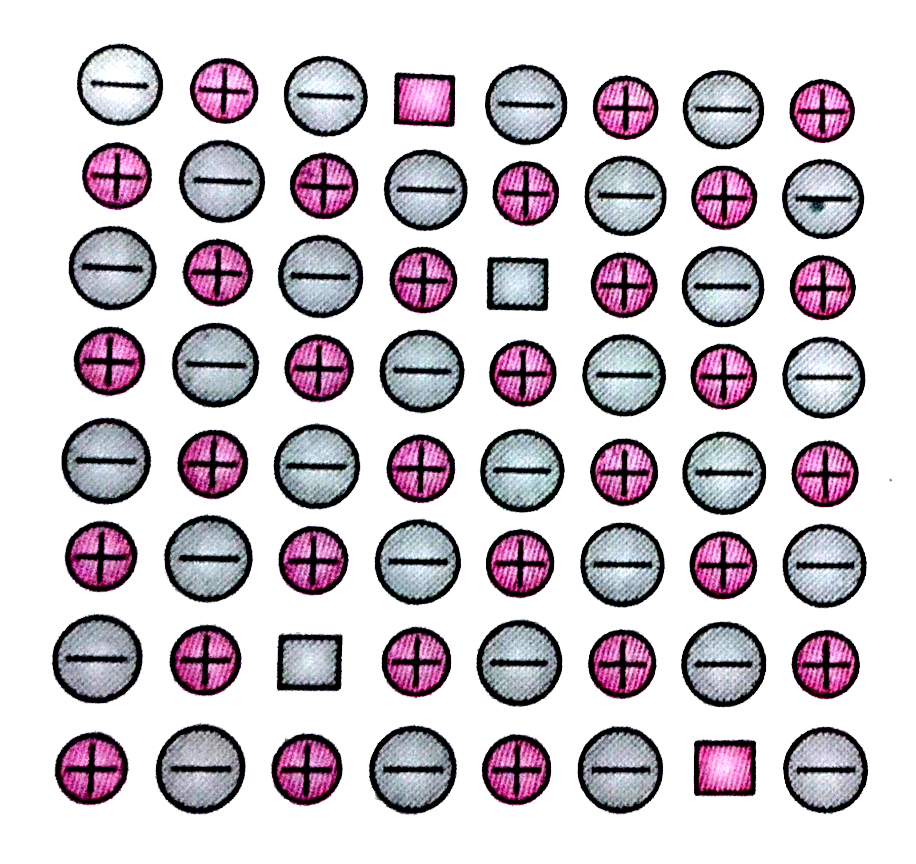Which of the following defect is seen in FeO
Metal excess defect
Metal deficiency defect
Displacement defect
Impurity defect
The correct Answer is:B
To determine which defect is seen in FeO (Iron(II) oxide), we will analyze the options provided and understand the characteristics of each defect type.
1. Understanding the Types of Defects:
- Schottky Defect: This defect occurs when an equal number of cations and anions are missing from the lattice, maintaining electrical neutrality.
- Frenkel Defect: This defect occurs when an ion is displaced from its lattice site to an interstitial site, creating a vacancy at the original site.
- Metal Deficiency Defect: This defect occurs in compounds with variable valency metals, where there is a deficiency of metal ions to maintain charge balance.
- Impurity Defect: This defect occurs when foreign atoms are introduced into the lattice, which can disrupt the regular arrangement of ions.
2. Analyzing FeO:
- FeO is composed of iron (Fe) and oxygen (O). Iron can exhibit variable valency, typically +2 and +3.
- In FeO, iron is in the +2 oxidation state. However, due to the presence of variable valency, there can be instances where some iron ions are missing to maintain charge neutrality.
3. Identifying the Defect:
- Given that FeO has iron in a variable oxidation state, it is likely to exhibit a metal deficiency defect. This is because, to maintain the overall charge balance in the crystal lattice, some Fe²⁺ ions may be missing.
4. Conclusion:
- The defect seen in FeO is a metal deficiency defect.
Final Answer:
The defect seen in FeO is a metal deficiency defect.
- Schottky Defect: This defect occurs when an equal number of cations and anions are missing from the lattice, maintaining electrical neutrality.
- Frenkel Defect: This defect occurs when an ion is displaced from its lattice site to an interstitial site, creating a vacancy at the original site.
- Metal Deficiency Defect: This defect occurs in compounds with variable valency metals, where there is a deficiency of metal ions to maintain charge balance.
- Impurity Defect: This defect occurs when foreign atoms are introduced into the lattice, which can disrupt the regular arrangement of ions.
- FeO is composed of iron (Fe) and oxygen (O). Iron can exhibit variable valency, typically +2 and +3.
- In FeO, iron is in the +2 oxidation state. However, due to the presence of variable valency, there can be instances where some iron ions are missing to maintain charge neutrality.
- Given that FeO has iron in a variable oxidation state, it is likely to exhibit a metal deficiency defect. This is because, to maintain the overall charge balance in the crystal lattice, some Fe²⁺ ions may be missing.
- The defect seen in FeO is a metal deficiency defect.
The defect seen in FeO is a metal deficiency defect.
Topper's Solved these Questions
- BOOK - ERRORLESSCHAPTER - SOLID STATEEXERCISE - PAST YEARS QUESTIONS38videos
SOLID STATE
- BOOK - ERRORLESSCHAPTER - SOLID STATEEXERCISE - ASSERTION & REASON11videos
SOLID STATE
- BOOK - ERRORLESSCHAPTER - SOLID STATEEXERCISE - NCERT BASED QUESTIONS (CRYSTAL STRUCTURE AND COORDINATION NUMBER)20videos
SOLID STATE
- BOOK - ERRORLESSCHAPTER - POLYMERSEXERCISE - ASSERTION & REASON4videos
POLYMERS
- BOOK - ERRORLESSCHAPTER - SOLUTIONS EXERCISE - ASSERTION AND REASON16videos
SOLUTIONS
Similar Questions
Knowledge Check
- Question 1 - Select One
Which of the following defects is present in KCl crystals ?
AFrenkelBSchottkyCLinearDImpurity - Question 2 - Select One
Which of the following defects is shown by KBr?
AFrenkel defectBSchottky defectCMetal excess defectDMetal deficiency defect - Question 3 - Select One
Which defect cause decrease in the density of crystal?
ASchottkyBFrinkelCF - centre defectDinterstitial
Which of the following disorder is seen in human female only ?
View Solutionwhich of the follwing defects is also known as dislocation defect ?
View Solutionwhich of the follwing defects is also known as dislocation defect ?
View SolutionWhich of the following defects, if present, lowers the density of the crystal ?
View SolutionWhich of the following defect, if present, lowers the density of the crystal?
View Solution

